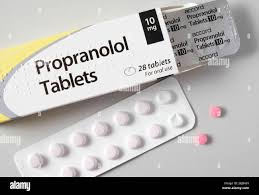
1. Introduction
Propranolol is a non-selective beta-adrenergic blocker used widely in clinical practice for a variety of cardiovascular and non-cardiovascular conditions. It was the first beta-blocker to be introduced for the treatment of hypertension and is still one of the most commonly prescribed beta-blockers worldwide. As a non-selective beta-blocker, propranolol inhibits both beta-1 and beta-2 adrenergic receptors, leading to a reduction in heart rate, myocardial contractility, and blood pressure.
Propranolol is also used in the treatment of conditions such as anxiety, migraine prophylaxis, and hyperthyroidism. Its broad range of indications, effectiveness, and well-established safety profile have made it a cornerstone of pharmacological therapy for various clinical conditions.
2. Pharmacology and Mechanism of Action
Propranolol works by blocking beta-adrenergic receptors, which are activated by catecholamines (such as norepinephrine and epinephrine). These receptors are primarily located in the heart, blood vessels, and lungs, and their activation typically leads to increased heart rate, myocardial contractility, and blood pressure. By blocking these effects, propranolol helps manage a variety of conditions.
- Beta-1 and Beta-2 Receptor Blockade: Propranolol is a non-selective beta-blocker, meaning it blocks both beta-1 receptors (primarily found in the heart) and beta-2 receptors (found in the lungs and blood vessels). The blockade of beta-1 receptors leads to a reduction in heart rate (negative chronotropy), myocardial contractility (negative inotropy), and overall oxygen demand of the heart. Beta-2 blockade can cause bronchoconstriction in the lungs, which can be problematic for patients with respiratory conditions like asthma or chronic obstructive pulmonary disease (COPD).
- Reduction in Blood Pressure: Propranolol lowers blood pressure by reducing heart rate and the force of heart contractions, ultimately reducing cardiac output. Additionally, it may have some vasodilatory effects due to beta-2 blockade in vascular smooth muscle, further contributing to blood pressure reduction.
- Antiarrhythmic Effects: By reducing heart rate and stabilizing myocardial cell excitability, propranolol can help control arrhythmias, particularly those arising from atrial or ventricular origins.
- Anxiolytic Effects: Propranolol is effective in reducing the physical symptoms of anxiety, such as tremors, tachycardia, and palpitations, by blocking the beta-adrenergic responses to stress.
3. Indications and Uses
Propranolol is used for a wide variety of clinical conditions:
- Hypertension: Propranolol is commonly used to treat high blood pressure by reducing cardiac output and decreasing systemic vascular resistance. It is often used when other medications are not effective or in combination with other antihypertensive agents.
- Angina Pectoris: Propranolol is used in the management of angina to reduce myocardial oxygen demand by lowering heart rate and myocardial contractility, thus preventing episodes of chest pain.
- Arrhythmias: Propranolol is used to treat certain types of arrhythmias, particularly atrial fibrillation, atrial flutter, and ventricular arrhythmias, by stabilizing the heart’s electrical activity and reducing heart rate.
- Post-Myocardial Infarction (MI): After a heart attack, propranolol is often prescribed to reduce the risk of reinfarction, prevent arrhythmias, and improve survival by decreasing myocardial oxygen demand and promoting recovery of the heart.
- Migraines: Propranolol is one of the most commonly prescribed medications for migraine prophylaxis. It helps reduce the frequency and severity of migraines by blocking beta-adrenergic receptors in the brain and preventing the dilation of cerebral blood vessels.
- Anxiety: Propranolol is sometimes used off-label to manage the physical symptoms of anxiety, such as tachycardia, trembling, and sweating. It is particularly effective for performance anxiety or public speaking.
- Hyperthyroidism: In hyperthyroid conditions (such as Graves’ disease), propranolol is used to control symptoms like tachycardia, tremors, and anxiety, as it can block the adrenergic effects of excess thyroid hormone.
4. Pharmacokinetics
Propranolol is well absorbed from the gastrointestinal tract, but it undergoes significant first-pass metabolism in the liver, which reduces its bioavailability.
- Absorption: Propranolol is absorbed rapidly after oral administration. However, due to extensive first-pass metabolism, its bioavailability is reduced to approximately 25-35%, meaning a larger dose is required to achieve therapeutic effects.
- Distribution: Propranolol is widely distributed throughout the body and is lipophilic, which means it crosses the blood-brain barrier and may cause central nervous system side effects, such as fatigue or sleep disturbances. It is approximately 90% protein-bound in plasma.
- Metabolism: Propranolol is extensively metabolized in the liver by cytochrome P450 enzymes (primarily CYP2D6). It undergoes both phase 1 and phase 2 metabolism to form inactive metabolites that are excreted in the urine.
- Excretion: Propranolol and its metabolites are primarily excreted in the urine. The half-life of propranolol is approximately 3 to 6 hours, which is relatively short, necessitating multiple daily doses to maintain consistent therapeutic effects.
5. Dosage and Administration
Propranolol is typically administered orally, but it is also available in intravenous form for acute situations. The dosing regimen depends on the condition being treated:
- For Hypertension: The usual starting dose for hypertension is 40 mg twice daily, with doses typically ranging from 80 to 320 mg per day, divided into 2 or 3 doses. The dose may be adjusted based on response.
- For Angina: Propranolol is typically started at 40 mg twice daily, with the dose adjusted based on clinical response. The usual dose ranges from 80 to 320 mg per day.
- For Arrhythmias: The dose for arrhythmias may vary, but it generally starts at 10 to 30 mg three to four times daily. The dose is adjusted depending on the type and severity of the arrhythmia.
- For Migraine Prophylaxis: Propranolol is typically started at 40 mg twice daily, with the dose gradually increased up to 160 mg twice daily, depending on the patient’s response and tolerance.
- For Anxiety: For performance anxiety or situational anxiety, propranolol is typically taken 30 minutes to 1 hour before the anxiety-provoking event. The typical dose is 10 to 40 mg, depending on the individual.
- For Hyperthyroidism: Propranolol is usually given in doses of 10 to 40 mg 3 to 4 times daily to control symptoms of hyperthyroidism.
6. Side Effects and Adverse Reactions
As a non-selective beta-blocker, propranolol can cause a range of side effects, particularly related to its cardiovascular and respiratory effects:
- Common Side Effects:
- Bradycardia: Propranolol can slow the heart rate, which may be problematic in patients with preexisting bradycardia or heart block.
- Fatigue: Due to its effects on the heart and the central nervous system, propranolol may cause fatigue or drowsiness.
- Cold Extremities: Reduced blood flow to the extremities due to beta-2 blockade can cause cold hands and feet.
- Dizziness or Lightheadedness: Especially when standing up quickly, due to its blood pressure-lowering effects.
- Serious Side Effects:
- Bronchoconstriction: As a non-selective beta-blocker, propranolol can cause bronchoconstriction, which may be dangerous in patients with asthma or chronic obstructive pulmonary disease (COPD).
- Heart Failure: Propranolol can worsen heart failure in some patients by reducing heart rate and myocardial contractility too much. It should be used with caution in patients with a history of heart failure.
- Hypoglycemia: Propranolol can mask the symptoms of hypoglycemia, such as tachycardia, in patients with diabetes, making it more difficult to detect low blood sugar levels.
- Sleep Disturbances: Propranolol can cross the blood-brain barrier, leading to sleep disturbances, nightmares, or vivid dreams in some patients.
7. Contraindications and Precautions
Propranolol should be used with caution or avoided in certain conditions:
- Asthma and COPD: Due to its beta-2 receptor blockade, propranolol can cause bronchoconstriction, which can worsen symptoms of asthma or COPD. It should generally be avoided in these conditions.
- Severe Bradycardia or Heart Block: Propranolol can further reduce heart rate and exacerbate conduction abnormalities in patients with preexisting heart block (especially second- or third-degree block).
- Heart Failure: In patients with decompensated heart failure, propranolol should be used with caution, as it may worsen symptoms by decreasing myocardial contractility.
- Pregnancy and Lactation: Propranolol is classified as a Category C drug during pregnancy, meaning its safety has not been fully established. It should be used during pregnancy only if the benefits outweigh the risks. Propranolol is excreted in breast milk, and caution
